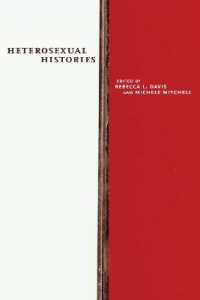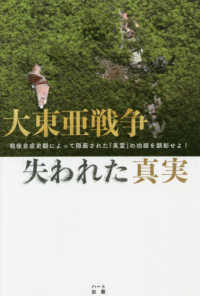Full Description
Cardiac Resynchronization Therapy continues to evolve at a rapid pace. Growing clinical experience and additional clinical trials are resulting in changes in how patients are selected for CRT. This new edition of the successful Cardiac Resynchronization Therapy builds on the strengths of the first edition, providing basic knowledge as well as an up-to-date summary of new advances in CRT for heart failure. Fully updated to include information on technological advances, trouble shooting and recent key clinical trials, and with nine new chapters, this expanded text provides the latest information, keeping the reader up-to-date with this rapidly evolving field. The second edition of Cardiac Resynchronization Therapy is an essential addition to your collection.
Contents
Contributors. Foreword. 1 The epidemiology of heart failure and commonly associated conduction disorders: Maren E. Jeffery (University of Pennsylvnia School of Medicine) & Mariell Jessup (University of Pennsylvnia School of Medicine). 2 Comprehensive pharmacologic management strategies for heart failure: Garrie J. Haas (The Ohio State University Medical Center) & William T. Abraham (Ohio State University). 3 Electrical activation sequence: Cecilia Fantoni (IRCCS Policlinico San Donato, Italy) & Angelo Auricchio (Fondazione Cardiocentro Ticino, Switzerland). 4 Myocardial mechano-energetics: Tammo Delhaas (Maastricht University) & Frits W. Prinzen (Maastricht University). 5 Assessment of electrical and mechanical dyssynchrony: conventional echocardiography Ole-A. Breithardt (Academic Teaching Hospital of the University of Wuerzburg). 6 Newer echocardiographic techniques for the assessment of cardiac resynchronization therapy: Cheuk-Man Yu (The Chinese University of Hong Kong) & Qing Zhang (The Chinese University of Hong Kong). 7 Value of non-echocardiographic imaging techniques in cardiac resynchronization therapy: Claudia Ypenburg (Leiden University Medical Center), Gabe B. Bleeker (Leiden University Medical Center), Martin J. Schalij (Leiden University Medical Center) & Jeroen J. Bax (Leiden University Medical Center). 8 Programming and diagnostic features of cardiac resynchronization therapy devices: David Luria (Sheba Medical Center and Tel Aviv University), Osnat Gurevitz (Sheba Medical Center and Tel Aviv University) & Michael Glikson (Heart Institute, Sheba Medical Center). 9 Anatomy of the coronary sinus: Samuel J. Asirvatham (Mayo Clinic College of Medicine). 10 Techniques for visualizing the coronary sinus and coronary venous anatomy: Jagmeet P. Singh (Charlton Memorial Hospital, Boston) & Angelo Auricchio (Fondazione Cardiocentro Ticino, Switzerland). 11 Implantation techniques for cardiac resynchronization therapy: Michael O. Sweeney (Harvard Medical School). 12 Surgical approaches to epicardial left ventricular lead implantation for biventricular pacing: Sandhya K. Balaram (St. Luke's-Roosevelt Hospital Center, New York), Joseph J. DeRose, Jr (St Luke's-Roosevelt Hospital Center, New York), & Jonathan S. Steinberg (St Luke's-Roosevelt Hospital Center, New York). 13 Remote navigation implantation technique: Carlo Pappone (San Raffaele University-Hospital, Italy) & Vincenzo Santinelli (San Raffaele University-Hospital, Italy). 14 Clinical trials supporting current indications for CRT: David L. Hayes (Mayo College of Medicine) & William T. Abraham (Ohio State University). 15 Trials of CRT in atrial fi brillation and atrial rhythm management issues: Maurizio Gasparini (IRCCS Istituto Clinico Humanitas, Italy) & Francois Regoli (IRCCS Istituto Clinico Humanitas, Italy). 16 Ongoing trials to further shape the future of CRT: David L. Hayes (Mayo College of Medicine) & Cheuk-Man Yu (The Chinese University of Hong Kong). 17 Consideration of CRT in the pediatric population: Anne M. Dubin (Lucile Packard Children's Hospital at Stanford University). 18 Importance of the surface electrocardiogram for the assessment of cardiac resynchronization: S. Serge Barold (Tampa General Hospital), Michael C. Giudici (Genesis Heart Institute, Davenport) & Bengt Herweg (Tampa General Hospital). 19 Troubleshooting: Christophe Leclercq (CHU Pontchaillou, France), Philippe Mabo (CHU Pontchaillou, France) & J. Claude Daubert (CHU Pontchaillou, France). 20 Optimization of cardiac resynchronization therapy: Jeffrey Wing-Hong Fung (The Chinese University of Hong Kong), Stephane Garrigue (Clinique Saint-Augustin, France) & Cheuk-Man Yu (The Chinese University of Hong Kong). 21 Management strategies for patients not responding to CRT: John P. Boehmer (The Penn State College of Medicine, Hershey). 22 Device-based monitoring and lung impedance: Jeffrey Wing-Hong Fung (The Chinese University of Hong Kong), Philip B. Adamson (Oklahoma Cardiovascular Associates/Oklahoma Heart Hospital) & Cheuk-Man Yu (The Chinese University of Hong Kong). 23 Device-based patient management: Maria Rosa Costanzo (Edward Heart Hospital, Naperville) & Salpy Pamboukian (University of Alabama). 24 Health economics: Francisco Leyva (Good Hope Hospital, Sutton Coldfield)








